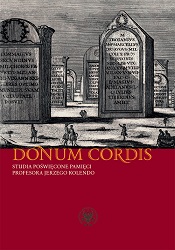Wśród przyjaciół w Krzemieńcu
Among friends in Krzemieniec
Author(s): Marta Męclewska
Subject(s): Archaeology
Published by: Wydawnictwa Uniwersytetu Warszawskiego
Keywords: Jerzy Kolendo; archaeology; Poland; Europe; University of Warsaw; Polish Academy of Sciences
Summary/Abstract: Professor Jerzy Kolendo in 1969 drew attention to an issue close to his heart, that is, the history of the numismaticcollection in the Krzemieniec school founded by Tadeusz Czacki in 1805. It was an exceptional collection – compiledat the Warsaw Castle at the order of King Stanisław August and after his death bought, together with the RoyalLibrary, for the Secondary School (Lyceum) in Krzemieniec. Professor Kolendo provided an outline of the subjectarea and a direction for further research, based on numerous studies and archive materials of the JagiellonianLibrary. Most importantly, he recommended that scholars gain access to the archives in Kiev, where he expectedto fi nd more abundant materials for the identifi cation of the collection from Krzemieniec. The goal set out by theProfessor started a path that was then followed by his students. The Numismatic Cabinet was created at the RoyalCastle in Warsaw in 1981, the aim of which was the study of the history of the royal numismatic collection, whichat the time was the largest one in Poland (over 18,000 objects, including approximately 8,400 ancient objects andmore than 9,400 modern ones). A team composed of the staff of the Castle and researchers from the University ofWarsaw, with the help of two study grants devoted to the history of the collection, conducted extensive archivalresearch in Polish archives and after 1991 also in Ukrainian, Lithuanian and Russian ones. As a result, afterthe penetration of 21 archives and libraries, an outline of the history of the collection was formulated, dividedinto four stages: 1) the Warsaw period – at the court of Stanisław August at the Castle in Warsaw (1764–1805);2) the Krzemieniec period (1805–1828); 3) the Vilnius period (1828–1834); 4) the Kiev period (1834–present day).The collection, transported to Krzemieniec (together with catalogues of ancient coins compiled in Warsaw byReverend John Baptist Albertrandi), waited until 1820 for the Numismatic Cabinet to be appropriately fi tted andfor the catalogues to be completed by the “keeper of the Cabinet,” Franciszek Skarbek-Rudzki. Despite that, in1811 a Visitor’s Book of the Cabinet was created – Liber inscribendorum nominum Eorum qui Cimelium NumismaticumGymnasii Volhyniensis Cremeneci visitavere. Anno 1811 – in which in the years 1811 and 1815–1827 were recordedvisits of eminent personages of the world of the sciences, representatives of the Volhynian gentry, great familiesof the Commonwealth, who supported the “Volhynian Athens” as the school was referred to. In the book wecan fi nd the fi nest names of the Polish intellectual, political and military elites. They formed Tadeusz Czacki’scircle of friends, involved institutionally and fi nancially in the organization of the school, making donations tothe various collections of the school and still taking care of the school after Tadeusz Czacki’s death in 1813 (exceptM. Nowosilcow). The end came in 1834 when the Russian authorities closed the school and when the collectionswere transported to Kiev. Today the collection is housed at the National Museum of the History of Ukraine,without the origins of the numismatic objects being preserved.
Book: Donum cordis. Studia poświęcone pamięci Profesora Jerzego Kolendo
- Page Range: 247-258
- Page Count: 11
- Publication Year: 2019
- Language: English, Polish, German
- Content File-PDF

